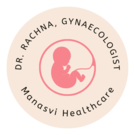When we talk about pregnancy, we often think of joy, movement, and the steady rhythm of growth. But sometimes, that rhythm slows down. During an ultrasound, the doctor may notice that the baby is not growing at the rate expected for the number of weeks. We call this condition Intrauterine Growth Restriction, or simply IUGR.
Now, what is intrauterine growth restriction exactly? In simple terms, it means the baby’s growth inside the uterus is slower than normal. The baby’s weight is usually below the tenth percentile for that stage of pregnancy. It is a sign that the baby may not be getting enough nutrients or oxygen through the placenta.
At Manasvi Healthcare, our goal is not only to detect IUGR early but to support both mother and baby through a carefully designed treatment plan.
Why Does IUGR Happen?
There is never one single cause. Many small factors together can influence the baby’s growth. Some are related to the mother, others to the placenta or the baby itself.
Common maternal causes include:
- High blood pressure or pre-eclampsia
- Long-standing anemia or malnutrition
- Kidney disease or chronic infections
- Smoking or alcohol intake during pregnancy
Placental causes are also common. If the placenta doesn’t function well, the baby receives less blood and oxygen. Twin pregnancies can also show growth restriction if one baby gets a larger share of blood flow than the other.
Fetal causes include chromosomal or genetic problems. Sometimes infections such as rubella or cytomegalovirus are responsible.
The good news is, many times, the exact reason can be identified and managed.
How We Detect IUGR?
Usually, the first clue appears when the uterus measures smaller than expected during a regular antenatal visit. The Obstetrics doctor in Rohini then recommends an ultrasound.
An ultrasound can measure the baby’s head, abdomen, and thigh bone. These numbers tell us whether the baby is growing steadily. A Doppler study checks blood flow in the umbilical cord and placenta. This test helps the doctor decide if the baby is receiving enough oxygen.
At our obstetrics clinic in Delhi, we repeat scans every two to three weeks. That pattern helps us track changes and respond quickly if the baby slows down further.
Different Types of IUGR
There are mainly two types of intrauterine growth restriction, and they behave quite differently.
- Symmetrical IUGR – Here the baby’s head, abdomen, and limbs are all proportionately small. It often starts early in pregnancy and may relate to chromosomal issues or infections.
- Asymmetrical IUGR – The head and brain grow normally, but the abdomen is smaller. It usually appears in the later months when the placenta starts losing efficiency.
Asymmetrical IUGR is more common and, with proper care, usually ends with a good outcome.
Why Type of intrauterine growth restriction is important?
When a baby doesn’t grow well, it’s not only about size. The condition may reduce oxygen supply, making the baby tired inside the womb. These babies can have low birth weight, struggle during labor, or have low blood sugar after birth.
In the long run, they may also face a slightly higher risk of developmental delay or learning problems, though many catch up beautifully when given proper nutrition and care.
That is why obstetricians focus on early detection and careful monitoring rather than waiting for complications to appear.
Intrauterine Growth Restriction Treatment
Now let’s talk about management. There isn’t a single medicine that magically increases fetal growth. Treatment means supporting the baby inside the womb for as long as it is safe.
At Manasvi Healthcare, the plan is always personalized. The doctor begins by controlling the mother’s health conditions, blood pressure, anemia, thyroid disorders, or infections. We also check if lifestyle changes can help.
You may hear the doctor say, “Let’s give the baby more rest time inside.” That means complete or partial bed rest to improve blood flow to the uterus. Lying on the left side works best because it helps blood reach the placenta easily.
Nutrition plays a big role. We recommend small frequent meals rich in protein, iron, and vitamins. Hydration is equally important.
If blood flow studies show worsening results the team discusses early delivery. The timing is critical. Delivering too early may bring premature complications but waiting too long may reduce oxygen further. Experienced doctors balance both sides carefully
How Delivery Is Planned
If the pregnancy is near term and the baby seems stable, a normal delivery may be possible. But when oxygen levels fall or heart patterns become irregular, a cesarean section delivery is often safer.
The hospital’s neonatal team remains ready at the time of birth. Babies with IUGR sometimes need special care for breathing or temperature maintenance during the first few days
Our obstetrician in Delhi always coordinates closely with pediatricians to ensure a smooth transition for both mother and baby
Life After Birth
Most babies with IUGR gain weight steadily after birth. The obs & gynae doctor keeps a close watch on feeding, body temperature, and sugar levels. Sometimes these babies stay in the neonatal intensive care unit for observation
Parents often ask if the child will stay small. The answer is reassuring many catch up in growth by two years of age. Regular follow-up visits help monitor progress and spot any developmental issues early
Emotional Support for Parents
Hearing that your baby is smaller than expected can be emotionally draining. Parents often blame themselves which is unnecessary. Remember, most causes of IUGR are beyond a mother’s control.
At Manasvi Healthcare our team believes emotional support is part of treatment. We encourage mothers to talk about their worries openly. Counseling and reassurance go a long way in helping families cope
Preventive Steps for Future Pregnancies
Once you’ve experienced IUGR, your next pregnancy will need closer observation. The best preventive strategy is early antenatal care.
Here are a few steps that truly help:
- Begin folic acid supplements before conception
- Attend all scheduled scans and check-ups
- Avoid smoking or alcohol completely
- Eat well-balanced meals and maintain good hydration
- Rest adequately and manage stress
- Control chronic conditions like hypertension or diabetes
Intrauterine Growth Restriction is a problem, but not a death sentence. When diagnosed at an early age, undergoing regular scans, and having the guided care, most babies develop well and have a healthy birth.
Manasvi Healthcare is no exception to such stories of successes each year. There are skilled obstetricians and pregnancy specialists in our team who will provide all the mothers with accurate checks, nutritional counseling and emotional support in the process.
Our vision is that no mother will have to struggle with the pregnancy anxiety on her own. The best means of effective delivery of your little one is through awareness, patience and trust with your medical team.
FAQs
What is intrauterine growth restriction and how serious is it?
It’s a condition where the baby’s growth slows inside the uterus. It can range from mild to severe. With proper monitoring, most pregnancies end safely.
Can IUGR be treated with medicines?
No specific drug can cure it. Treatment focuses on improving blood flow, rest, nutrition and managing any underlying maternal condition
How will I know if my baby has IUGR?
When your doctor examines you, he can recognize that your stomach is not as large as it should be. The diagnosis is proved by ultrasound and Doppler tests.
Will I need an early delivery?
Only if tests show that the baby’s oxygen or blood flow is getting worse
Can I prevent IUGR in my next pregnancy?
Yes. Healthy habits, early antenatal care and control of existing health problems greatly reduce the risk.




